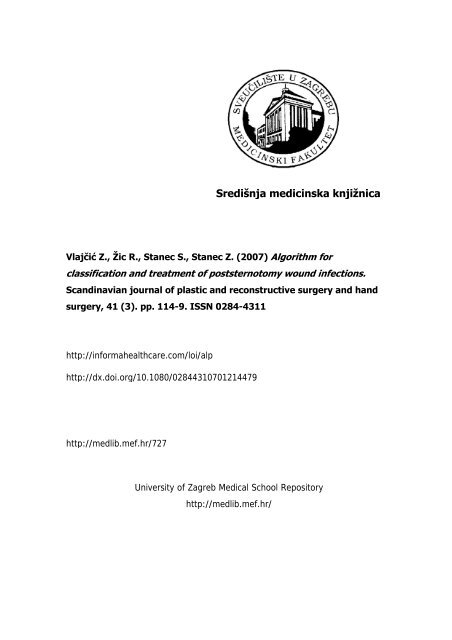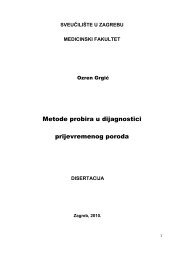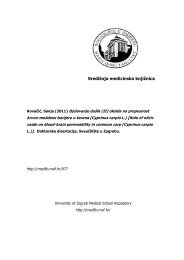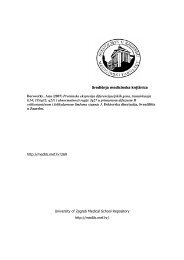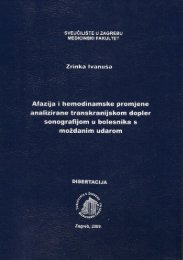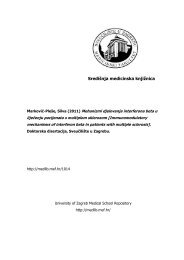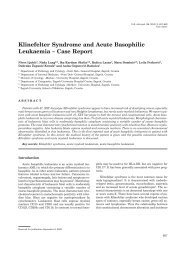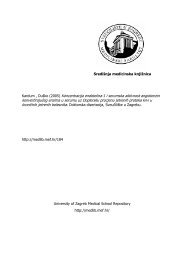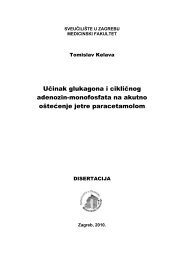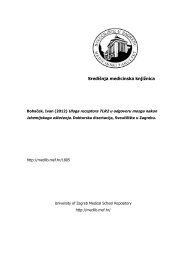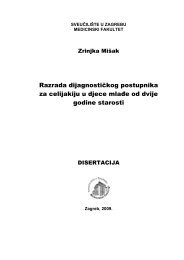Algorithm for classification and treatment of poststernotomy wound ...
Algorithm for classification and treatment of poststernotomy wound ...
Algorithm for classification and treatment of poststernotomy wound ...
You also want an ePaper? Increase the reach of your titles
YUMPU automatically turns print PDFs into web optimized ePapers that Google loves.
Središnja medicinska knjižnicaVlajčić Z., Žic R., Stanec S., Stanec Z. (2007) <strong>Algorithm</strong> <strong>for</strong><strong>classification</strong> <strong>and</strong> <strong>treatment</strong> <strong>of</strong> <strong>poststernotomy</strong> <strong>wound</strong> infections.Sc<strong>and</strong>inavian journal <strong>of</strong> plastic <strong>and</strong> reconstructive surgery <strong>and</strong> h<strong>and</strong>surgery, 41 (3). pp. 114-9. ISSN 0284-4311http://in<strong>for</strong>mahealthcare.com/loi/alphttp://dx.doi.org/10.1080/02844310701214479http://medlib.mef.hr/727University <strong>of</strong> Zagreb Medical School Repositoryhttp://medlib.mef.hr/
Original Paper:<strong>Algorithm</strong> <strong>for</strong> <strong>classification</strong> <strong>and</strong> <strong>treatment</strong> algorithm <strong>of</strong><strong>poststernotomy</strong> <strong>wound</strong> infectionsZlatko Vlajcic, Rado Zic, S<strong>and</strong>a Stanec & Zdenko StanecDepartment <strong>of</strong> Plastic Surgery, University Hospital “Dubrava”, Zagreb, CroatiaCorrespondence: Zlatko Vlajcic, MD, MSc, Department <strong>of</strong> Plastic Surgery, UniversityHospital “Dubrava”, Av. Gojka Suska 6, HR-10000 Zagreb, Croatia. Fax: +385 1 290 2451.Tel: +385 98 60 77 60. E-mail: zvlajcic@kbd.hrBrief title: Sternotomy infections, <strong>treatment</strong> algorithm
AbstractThe <strong>treatment</strong> <strong>of</strong> sternal <strong>wound</strong> infection still carries high mortality. Treatment preferencesrange from more conservative <strong>treatment</strong>s that do not include flaps, to more aggressivereconstructions using different types <strong>of</strong> flaps, <strong>and</strong> these could be resolved <strong>and</strong> st<strong>and</strong>ardisedusing a proper <strong>classification</strong> with a <strong>treatment</strong> algorithm. We propose modification <strong>of</strong> theexisting <strong>classification</strong>, with different proposals <strong>for</strong> <strong>treatment</strong>, stressing the importance <strong>of</strong> theradicality <strong>of</strong> debridement, <strong>and</strong> report our results in 31 patients, 24 <strong>of</strong> whom were wellsatisfied. Eleven were left with some pain in the chest wall, <strong>and</strong> eight each with somemuscular weakness <strong>and</strong> less than adequate cosmesis. We would also like to recommend theomental flap as the first choice <strong>for</strong> selected cases. With our selective approach, we haveachieved good functional <strong>and</strong> aesthetic results with satisfied patients.Key words: Sternal <strong>wound</strong>, <strong>classification</strong>, <strong>treatment</strong> algorithm, follow-up
IntroductionThe reported incidence <strong>of</strong> sternal <strong>wound</strong> infection after median sternotomy ranges from 0.4%to 5.9% [1], but the mortality is still high, varying from 14% [2] to 47% [3]. Obviously, thisclinical entity, after cardiac surgical procedures, is still a significant problem.There has been a trend <strong>for</strong> cardiac surgeons to prefer a more conservative approach tothe <strong>treatment</strong> <strong>of</strong> sternal <strong>wound</strong> infections with rewiring <strong>of</strong> the sternum <strong>and</strong> closed mediastinalirrigation. Pedicled flaps have been reserved as a second line <strong>treatment</strong> in case the first fails[4]. Plastic surgeons prefer a more aggressive approach with early debridement <strong>and</strong> closurewith the muscle flaps <strong>of</strong> infected median sternotomy <strong>wound</strong>s as “the st<strong>and</strong>ard against whichall other <strong>treatment</strong> modalities must be compared” [5].There is also the question <strong>of</strong> the best timing <strong>of</strong> the reconstruction. A one-stageprocedure has been advocated, <strong>and</strong> confirmed in more recent reports [6]. As a modification <strong>of</strong>the procedure, a short intraoperative inflation <strong>of</strong> the SpaceMaker balloon to exp<strong>and</strong> pectoralismajor <strong>and</strong> enable tensionless closure has been described [7]. A two-stage closure has beensuggested by Pairolero et al. [8]. As a bridge between debridement <strong>and</strong> delayed closure intwo-stage <strong>wound</strong> <strong>treatment</strong>, vacuum assisted closure was recently described [9].Finally, the debate has also been oriented towards the choice <strong>of</strong> initial reconstructivematerial. While most advocate the use <strong>of</strong> pedicled muscle or musculocutaneous flaps as thefirst choice <strong>and</strong> an omental flap only as a “life boat”, others prefer to use the omental flapinitially as proposed by Lopez–Monjardin et al. [10].Free flaps are also an option <strong>for</strong> sternal reconstruction [6].In line with the experience that we gained during the recent war in Croatia with the<strong>treatment</strong> <strong>of</strong> lower extremities war <strong>wound</strong>s as high-energy <strong>wound</strong>s or defects, we prefer the“pseudo-tumoral” approach to infected <strong>poststernotomy</strong> <strong>wound</strong>s, consisting <strong>of</strong> radical
esection <strong>of</strong> all non-viable tissue <strong>and</strong> reconstruction with well-vascularised tissue in a onestageprocedure.Patients <strong>and</strong> MethodsThe clinical records <strong>of</strong> all patients treated at the Department <strong>of</strong> Plastic Surgery, UniversityHospital "Dubrava", Zagreb, with flaps <strong>for</strong> <strong>poststernotomy</strong> <strong>wound</strong> infections were studied.The initial cardiac surgery was done at the Department <strong>of</strong> Cardiac Surgery, UniversityHospital “Dubrava”, Zagreb, University Hospital Center “Rebro”, Zagreb, <strong>and</strong> SpecialHospital <strong>for</strong> Cardiology <strong>and</strong> Cardiothoracic Surgery “Magdalena”, Krapinske Toplice, from1996 to 2004. All patients had been previously treated unsuccessfully by Robicsek's rewiring<strong>of</strong> the sternum [11] <strong>and</strong> closed mediastinal irrigation or open packing with attempts atsecondary closure. Our intention was not to define the risk factors <strong>for</strong> postoperative sternal<strong>wound</strong> infection, because our group <strong>of</strong> patients was not big enough to resolve the issue.Patients were entered into the study at their first consultation with the plastic surgeon.A history was taken, clinical examination made, <strong>and</strong> the <strong>poststernotomy</strong> <strong>wound</strong> infectioncategorised. We had no influence on the previous <strong>treatment</strong>s during the patients' stay at theCardiac Department, <strong>and</strong> the microbiological cultures were usually taken in that department.The overall incidence <strong>of</strong> sternal <strong>wound</strong> infection after median sternotomy was 3%, mostlyGram-positive bacteria. Staphylococcus aureus was isolated in 12/31 <strong>and</strong> S epidermidis in9/31 <strong>of</strong> the cases. We did not use quantitative tissue cultures to decide the timing <strong>of</strong> <strong>wound</strong>closure. Our modified <strong>classification</strong> <strong>of</strong> <strong>poststernotomy</strong> <strong>wound</strong> is shown in Table I.The clinical follow-up was prospective <strong>and</strong> ranged from 3 weeks to 8 years (Table II).Haematomas, sternal instability, hernias <strong>and</strong> bulges, skin necrosis, de<strong>for</strong>mities <strong>of</strong> the chestcontour (axillary hollows), deaths, primary or secondary closure, <strong>and</strong> recurrence <strong>of</strong> infectionswere recoreded with photographs <strong>and</strong> questionnaire. The questionnaire was need to assess
subjective chest wall pain, cosmesis, <strong>and</strong> shoulder or abdominal weakness, through the abilityto do daily activities (to st<strong>and</strong> from a sitting or supine position, to open a door, <strong>and</strong> to lift <strong>and</strong>carry a bag <strong>of</strong> groceries), <strong>and</strong> to grade overall satisfaction (Table III).From 1996 to 2004, we treated 31 patients with sternal <strong>wound</strong> infections by radicaldebridement <strong>and</strong> reconstruction with pedicled flaps. Most <strong>of</strong> our cases were type 2B (13/31)<strong>and</strong> 2C (10/31). There were also six <strong>of</strong> type 3, <strong>and</strong> two <strong>of</strong> type 4. Types 1 <strong>and</strong> 2A, wereusually successfully treated by the cardiac surgeons with open packing <strong>and</strong> secondary closureor rewiring. All our patients were seen when their <strong>wound</strong>s were in chronic phase according tothe <strong>classification</strong> <strong>of</strong> El Oakley <strong>and</strong> Wright [4], usually three or more weeks after open heartsurgery.Surgical <strong>treatment</strong>, under general anaesthesia, consisted <strong>of</strong> radical debridement <strong>of</strong> allnecrotic s<strong>of</strong>t tissue, bone, <strong>and</strong> costal cartilage with simultaneous reconstruction, except <strong>for</strong> thetype 4, which were treated by delayed closure after aggressive <strong>treatment</strong> with antibioticsgiven parenterally, <strong>and</strong> chosen according to the results <strong>of</strong> quantitative tissue culture. When theentire sternum was devascularised or necrotic, we did not hesitate to remove the sternum. Allflaps <strong>for</strong> reconstruction were pedicled. The reconstructive options <strong>for</strong> sternal osteitis withnon-viable bone may be divided depending on the site <strong>of</strong> the sternal dehiscence or instability(2B <strong>and</strong> 2C). Patients with upper <strong>and</strong> middle third defects were treated with bilateral orunilateral pectoralis major transposition flaps or turnover flaps. The patients with lower thirddefects were treated with VRAM (vertical rectus abdominis musculocutaneous) flaps, omentalflaps, bipedicled composite pectoralis major <strong>and</strong> rectus abdominis flaps <strong>and</strong> a latissimus dorsiflap was used in only one case. For type 3 <strong>and</strong> 4 we used omentum alone or omentum withVRAM or pectoralis major advancement musculocutaneous flaps <strong>for</strong> additional cover.However, we prefer to close the overlying skin <strong>and</strong> subcutaneous tissue directly afterundermining, if possible.
ResultsThirty-one patients had sternal reconstructive procedures <strong>and</strong> were followed up <strong>for</strong> 3 weeks to8 years (mean 3 years). The small sample size precluded statistical analysis but trends werenoted related to complications <strong>and</strong> patients' satisfaction. Four patients died, all <strong>of</strong> whom hadco-existing conditions (diabetes mellitus, hypertension, <strong>and</strong> atherosclerosis) in addition to theunderlying cardiac disease. One patient died three weeks after reconstruction <strong>and</strong> three <strong>of</strong>them after discharge. No deaths were connected to the reconstructive procedure. Theirhospital stay ranged from 8 to 40 days (median 18). All had healed <strong>wound</strong>s at the time <strong>of</strong>death or discharge, 29 closed primarily two secondarily.One case <strong>of</strong> skin necrosis was connected to the composite pectoralis major <strong>and</strong> rectusabdominis flap <strong>and</strong> the second one to a VRAM flap. Clinically confirmed instability <strong>of</strong> thethoracic wall was noted in only one patient who had been treated by total sternectomy <strong>and</strong>reconstruction with an omental flap but with no respiratory dysfunction. All cases <strong>of</strong> totalsternectomy (8/31) were type 3 or 4 <strong>and</strong> had the great omentum transposed as the first choice,either immediately (n=6) or after a delay <strong>of</strong> 24 to 48 hours (n=2). No case <strong>of</strong> chronic pain inthe chest wall was associated with total sternectomy. Mediastinitis was definitively cured inall cases by total sternectomy <strong>and</strong> omental flaps.Unsatisfactory cosmesis was clearly associated with the VRAM flap (Figure 1). Most<strong>of</strong> our patients were not as concerned with the length <strong>of</strong> the scar as with the bulge in thesternal region, which they regarded as the reason <strong>for</strong> the “unsatisfactory cosmesis”. Twopatients who had partial sternectomy developed minor recurrence <strong>of</strong> the infection (cutaneousfistulas) after three <strong>and</strong> six years postoperatively, respectively. Both were cured by removingthe remaining wire from the upper part <strong>of</strong> the sternum. Clinically obvious hernias werenoticed in two cases; in one the abdominal wall weakness was associated with the compositepectoralis major-rectus abdominis reconstruction, <strong>and</strong> the other was a true suprapubic hernia
elated to the VRAM flap, but both patients refused reoperation. Minor abdominal wallweaknesses were <strong>of</strong>ten noticed in association with the VRAM reconstruction in the distal part<strong>of</strong> the abdomen, <strong>and</strong> axillary hollows (Figure 2) were related to the transposition <strong>and</strong>advancement flap <strong>of</strong> pectoralis major with resection <strong>of</strong> the humeral attachment in 5/8 cases.The overall satisfaction in 24 patients was high (Table III).DiscussionThere is no single ideal <strong>treatment</strong> <strong>for</strong> all cases <strong>of</strong> sternal <strong>wound</strong> infection. For this reason,proper <strong>classification</strong> should logically suggest the <strong>treatment</strong> modalities. As far as we know,there are three <strong>classification</strong>s about this entity.The <strong>classification</strong>sThe <strong>classification</strong> <strong>of</strong> El Oakley <strong>and</strong> Wright [4] is related to the time that the mediastinitispresents, <strong>and</strong> the presence or absence <strong>of</strong> risk factors, with no distinction between a stable <strong>and</strong>unstable sternum.That <strong>of</strong> Pairolero et al. [8] is chronological. Type I occurs within days after operation,type II within the first few weeks <strong>and</strong> type III occurs months to years later.The <strong>classification</strong> made by Jones et al. [12] considers the exact <strong>wound</strong>, but the flaw intheir <strong>classification</strong> is the failure to classify separately sterile instability <strong>of</strong> the sternum orsterile <strong>wound</strong> dehiscence with viable bone, which is said to be present in 60% <strong>of</strong> patients[13]. This distinction is important <strong>for</strong> <strong>treatment</strong>. There is however, an unnecessary distinctionbetween two superficial types <strong>of</strong> <strong>wound</strong>s (1A <strong>and</strong> 1B). A further objection is the lack <strong>of</strong>definition <strong>of</strong> mediastinitis, as Pairolero et al. <strong>and</strong> El Oakley <strong>and</strong> Wright have done.Mediastinitis is defined by El Oakley <strong>and</strong> Wright as a “<strong>wound</strong> infection associatedwith sternal osteomyelitis with or without infected retrosternal space”, which means that theymake no clear distinction between sternal osteitis <strong>and</strong> mediastinitis. We think that
mediastinitis should be defined as the inflammation <strong>of</strong> cellular tissue in the mediastinum,because its <strong>treatment</strong> is urgent, <strong>and</strong> differs from the <strong>treatment</strong> <strong>of</strong> osteomyelitis <strong>of</strong> the sternum.A good <strong>classification</strong> should suggest the <strong>treatment</strong> <strong>for</strong> each group <strong>of</strong> patients.Important variables that should be included in any <strong>classification</strong> <strong>and</strong> <strong>treatment</strong> <strong>of</strong><strong>poststernotomy</strong> <strong>wound</strong> infections are: the presence <strong>of</strong> sternal instability with a distinctionmade between sternal dehiscence with viable uninfected bone <strong>and</strong> sternal dehiscence withosteomyelitis, <strong>and</strong> the presence or absence <strong>of</strong> suppurative mediastinitis, or a more precisedistinction between sternal osteitis <strong>and</strong> mediastinitis.Delayed closure <strong>for</strong> 48h with aggressive antibiotics given parenterally <strong>for</strong> type 4 isessential. More than 48h delay could be associated with desiccation <strong>and</strong> rupture <strong>of</strong> coronarygrafts <strong>and</strong> ventricular wall.Radical debridementTwo cases <strong>of</strong> local recurrence in our follow-up, after three <strong>and</strong> six years, might have resultedfrom the partial sternectomy. We found no case <strong>of</strong> local recurrence after total sternectomy.The importance <strong>of</strong> radical debridement has been tested <strong>and</strong> confirmed over many years.According to Kohman et al. [14], even total sternectomy without stabilisation <strong>of</strong> thethoracic wall will not affect late pulmonary function, <strong>and</strong> the comparison betweendebridement <strong>and</strong> flap coverage <strong>and</strong> sternal rewiring gives no difference in stability or strength<strong>of</strong> the chest wall [15]. This is an additional argument <strong>for</strong> radical debridement as the mostimportant factor <strong>of</strong> infection control. In our follow-up chest wall pain was not related to totalsternectomy but to some partial sternectomies, which might be explained by the prevention <strong>of</strong>painful contact <strong>of</strong> the bony edges in total sternectomy as noted by Wettstein et al. [6].Choice <strong>of</strong> flapWe do not accept the tenet about the choice <strong>of</strong> reconstructive procedure <strong>for</strong> mediastinitis (type3) “being unnecessary to actually fill the mediastinum with our flaps [16]”, <strong>and</strong> would like to
accentuate the obliteration <strong>of</strong> the dead space with vascularised tissue as an important aspect <strong>of</strong>infection control instead <strong>of</strong> covering only the <strong>wound</strong>.The disadvantages <strong>for</strong> transposition <strong>of</strong> pectoralis major (based on the thoracoacromialarteries) is that it gives insufficient volume to fill some <strong>of</strong> the larger defects <strong>of</strong>ten created bywide debridement, <strong>and</strong> particularly makes it difficult to reach the inferior third <strong>of</strong> the sternum.Nevertheless, transposition <strong>of</strong> pectoralis major remains the flap <strong>of</strong> choice <strong>for</strong> type 2B due toits simplicity <strong>and</strong> efficiency.Reconstruction <strong>of</strong> the lower third <strong>of</strong> the sternum (type 2C) is more difficult,particularly after unilateral or bilateral usage the internal mammary artery <strong>for</strong> myocardialrevascularisation or lesion <strong>of</strong> the artery during rewiring or sternectomy. A pectoralis majorturnover flap (based on per<strong>for</strong>ators <strong>of</strong> the internal mammary) there<strong>for</strong>e cannot be used safely.The same applies to the VRAM flap, but we also have additional concerns about theinconsistent viability <strong>of</strong> the distal portion <strong>of</strong> the skin isl<strong>and</strong> <strong>and</strong> weakness <strong>of</strong> the abdominalwall. Any lesion <strong>of</strong> the superior epigastric artery involving a previous subcostal incision couldalso preclude the use <strong>of</strong> this flap. The latissimus dorsi pedicled flap is also insufficient tocover this region <strong>and</strong> its dem<strong>and</strong>s <strong>for</strong> extensive subcutaneous dissection, which increases theincidence <strong>of</strong> seromas, <strong>and</strong> haematomas <strong>and</strong> could promote infection. The same applies to thecomposite pectoralis major - rectus abdominis flap. Two <strong>of</strong> our cases <strong>of</strong> skin necrosis wereassociated with the use <strong>of</strong> this <strong>and</strong> the VRAM flap.Omental flapWe found that the omental flap, with direct skin closure or advancement <strong>of</strong> pectoralis major<strong>for</strong> additional cover, was the flap <strong>of</strong> choice <strong>for</strong> selected cases (type 3) from both the functional<strong>and</strong> the aesthetic results (Figure 3). Omentum is an excellent source <strong>of</strong> tissue volume whichcan reach the deepest recesses <strong>of</strong> the sternal <strong>wound</strong> <strong>and</strong> obliterate it. It has good vascularity,lymphatic vessels that can absorb exudates rapidly, <strong>and</strong> immunological <strong>and</strong> biological
attributes, including cellular proliferation <strong>and</strong> fibrous tissue <strong>for</strong>mation. It is there<strong>for</strong>eassociated with fewer infective complications than the pectoralis major flap alone [10].Omental lipid extract also has an angiogenic effect [17]. The disadvantage <strong>of</strong> using theomentum is the possibility <strong>of</strong> intra-abdominal infection, <strong>and</strong> complications such as epigastricherniation, <strong>and</strong> bowel obstruction. The use <strong>of</strong> the omentum is not indicated in patients whohave had previous major upper abdominal surgery.We know <strong>of</strong> only one published case <strong>of</strong> infection that was propagated into theabdominal cavity as a subphrenical abscess [18], but one <strong>of</strong> the authors <strong>of</strong> that paper statedthat they had no found intra-abdominal sepsis [12]. Pairolero et al. [8] noticed five <strong>of</strong> 19patients with omental transpositions who developed asymptomatic hernias through the tunnelby which the omentum was passed, but these did not require intervention. Laparoscopicdissection <strong>and</strong> mobilisation <strong>of</strong> the omentum eliminates the major drawback <strong>of</strong> using theomentum – laparotomy but it is still optional.Our results support our modification <strong>of</strong> the <strong>classification</strong> with suggestions <strong>for</strong><strong>treatment</strong> <strong>of</strong> each group <strong>of</strong> patients. They also stress the importance <strong>of</strong> radical debridement asthe dominant factor influencing the outcome <strong>of</strong> patients with <strong>poststernotomy</strong> <strong>wound</strong>infections. In patients with type 3 or 4 <strong>of</strong> sternal <strong>wound</strong> infection (suppurative mediastinitis)the omental flap is our first choice with direct skin closure. In patients with larger defects orinsufficient skin <strong>for</strong> direct closure the omentum should be covered with muscle flaps(pectoralis major advancement flap) be<strong>for</strong>e closure or grafting <strong>of</strong> the skin.
AcknowledgementsWe thank Dr. J. Skrlin, MD, PhD, Department <strong>of</strong> Clinical Microbiology <strong>and</strong> HospitalInfections, University Hospital “Dubrava” Zagreb, Croatia, <strong>and</strong> Pr<strong>of</strong>.. Z. Sutlic, MD, PhD,Department <strong>of</strong> Cardiac Surgery, University Hospital “Dubrava” Zagreb, Croatia, <strong>for</strong> theircontributions to this work.
References[1] Oh AK, Lechtman AN, Whetzel TP, Stewenson TR. The infected median sternotomy<strong>wound</strong>: management with the rectus abdominis musculocutaneous flap. Ann Plast Surg2004;52:367-70.[2] Loop FD, Lytle BW, Cosgrove DM, et al. J. Maxwell Chamberlain memorial paper.Sternal <strong>wound</strong> complications after isolated coronary artery bypass grafting: early <strong>and</strong> latemortality, morbidity, <strong>and</strong> cost <strong>of</strong> care. Ann Thorac Surg 1990;49:179-87.[3] Serry C, Bleck PC, Javid H, et al. Sternal <strong>wound</strong> complications. Management <strong>and</strong> results.J Thorac Cardiovasc Surg 1980;80:861-7.[4] El Oakley RM, Wright JE. Postoperative mediastinitis: <strong>classification</strong> <strong>and</strong> management.Ann Thorac Surg 1996;61:1030-6.[5] Ringelman PR, V<strong>and</strong>er Kolk CA, Cameron D, Baumgartner WA, Manson PN. Long-termresults <strong>of</strong> flap reconstruction in median sternotomy <strong>wound</strong> infections. Plast Reconstr Surg1994;93:1208-16.[6] Wettstein R, Erni D, Berdat P, Rothenfluh D, Banic A. Radical sternectomy <strong>and</strong> primarymusculocutaneous flap reconstruction to control sternal osteitis. J Thorac Cardiovasc Surg2002;123:1185-90.[7] Hauben DJ, Shulman O, Levi Y, Sulkes J, Amir A, Silfen R. Use <strong>of</strong> the SpaceMakerballoon in sternal <strong>wound</strong> closure: comparison with other techniques. Plast Reconstr Surg2001;108:1582-90.[8] Pairolero PC, Arnold PG, Harris JB. Long-term results <strong>of</strong> pectoralis major muscletransposition <strong>for</strong> infected sternotomy <strong>wound</strong>s. Ann Surg 1991;213:583-90.[9] Song DH, Wu LC, Lohman RF, Gottlieb LJ, Franczyk M. Vacuum assisted closure <strong>for</strong> the<strong>treatment</strong> <strong>of</strong> sternal <strong>wound</strong>s: the bridge between debridement <strong>and</strong> definitive closure. PlastReconstr Surg 2003;111:92-7.
[10] Lopez–Monjardin H, de-la-Pena–Salcedo A, Mendoza–Munoz M, Lopez-Yanez-de-la-Pena A, Palacio-Lopez E, Lopez-Garcia A. Omentum flap versus pectoralis major flap in the<strong>treatment</strong> <strong>of</strong> mediastinitis. Plast Reconstr Surg 1998;101: 1481–5.[11] Robicsek F, Daugherty HK, Cook JW. The prevention <strong>and</strong> <strong>treatment</strong> <strong>of</strong> sternumseparation following open-heart surgery. Coll Works Cardiopulm Dis 1977;21:61-3.[12] Jones G, Jurkiewicz MJ, Bostwick J, et al. Management <strong>of</strong> the infected mediansternotomy <strong>wound</strong> with muscle flaps. The Emory 20-year experience. Ann Surg1997;225:766-78.[13] Bryan AJ, Lamarra M, Angelini GD, West RR, Breckenridge IM. Median sternotomy<strong>wound</strong> dehiscence: a retrospective case control study <strong>of</strong> risk factors <strong>and</strong> outcome. J R CollSurg Edinb 1992;37:305-8.[14] Kohman LJ, Auchincloss JH, Gilbert R, Beshara M. Functional results <strong>of</strong> muscle flapclosure <strong>for</strong> sternal infection. Ann Thorac Surg 1991;52:102-6.[15] Francel TJ, Kouchoukos NT. A rational approach to <strong>wound</strong> difficulties after sternotomy:reconstruction <strong>and</strong> long-term results. Ann Thorac Surg 2001;72:1419-29.[16] Ascherman JA, Patel SM, Malhotra SM, Smith CR. Management <strong>of</strong> sternal <strong>wound</strong>s withbilateral pectoralis major myocutaneous advancement flaps in 114 consecutively treatedpatients: refinements in technique <strong>and</strong> outcomes analysis. Plast Reconstr Surg 2004;114:676-83.[17] Cartier R, Brunette I, Hashimoto K, Bourne WM, Schaff HV. Angiogenic factor: apossible mechanism <strong>for</strong> revascularization produced by omental pedicles. J Thorac CardiovascSurg 1990;99:264-8.[18] Pairolero PC, Arnold PG. Management <strong>of</strong> recalcitrant median sternotomy <strong>wound</strong>s. JThorac Cardiovasc Surg 1984;88:357-64.
Legends to figuresFigure 1. Thoracic bulge six years after vertical rectus abdominis musculocutaneous flapreconstruction with the: (a) Frontal <strong>and</strong> (b) side view. The patient declined proposedliposuction.Figure 2. (a) Frontal <strong>and</strong> (b) side view showing the axillary hollow four years after the sternalreconstruction with a pectoralis major bilateral transposition flap.
Figure 3. (a) Frontal <strong>and</strong> (b) side view showing a good result with an omental flap two yearsafter the reconstruction.
Table I. Modification <strong>of</strong> the Jones’s <strong>classification</strong> <strong>of</strong> sternal <strong>wound</strong> infectionType Classification <strong>of</strong> <strong>wound</strong> First choice <strong>of</strong> <strong>treatment</strong>1 Superficial <strong>wound</strong> dehiscenceStable sternumSterile (Gram stain <strong>of</strong> fluid from sternal puncture)Debridement, dressing, secondary closure – direct, local flaps orsplit-skin graft2 Unstable sternum (sternal dehiscence)A-Sterile viable boneB-Sternal osteitis, non-viable bone, upper two-thirdsC- Sternal osteitis, non-viable bone, lower thirdDebridement, rewiring (Robicsek)Partial sternectomy (radical debridement)Pedicled pectoralis major transposition, advancement or turnoverPartial sternectomy (radical debridement)Pedicled omental flap (second choice - latissimus dorsi,bipedicled pectoralis major plus rectus abdominis, or VRAM)3 Mediastinitis (suppurative) Total sternectomyOmentum pedicled flap plus pectoralis major advancement flap4 2 or 3 with septicaemia Radical debridement, delayed closure (
Table II Outcome <strong>of</strong> reconstructionFlapsTotalNoTotalsternectomyUnstablethoraciswallHaematomaPartialskinnecrosisRecurrentinfectionHernia Bulges AxillaryhollowsPectoralis major:Bilateral 8 0 0 0 0 1 0 2 5transpositionUnilateral 2 0 0 0 0 1 0 0 0transpositionTurnover 2 0 0 0 0 0 0 0 0Plus rectus 3 0 0 1 1 0 1 0 2abdominis(composite)VRAM 7 0 0 1 1 0 1 5 0Omentum:Alone 4 4 1 0 0 0 0 0 0Plus VRAM 1 1 0 0 0 0 0 1 0Plus3 3 0 0 0 0 0 0 0pectoralismajoradvancementLatissimus 1 0 0 1 0 0 0 1 0Total 31 8 1 3 2 2 2 9 7VRAM = Vertical rectus abdominis musculocutaneous flap
Table III. The patients observations from the questionnaireFlapTotalNoPain inchestwallMuscularweaknessPoorcosmesisOverallsatisfatactionPectoralis major:Bilateral transposition 8 5 4 0 7Unilateral transposition 2 1 0 0 2Turnover 2 0 1 0 2Plus rectus abdominis3 2 1 1 2(composite)VRAM 7 2 2 6 3Omentum:Alone 4 0 0 0 5Plus VRAM 1 0 0 1 0Plus pectoralis major3 0 0 0 2advancementLatissimus 1 1 0 0 1Total 31 11 8 8 24VRAM = Vertical rectus abdominis musculocutaneous flap


